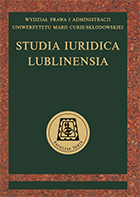
We kindly inform you that, as long as the subject affiliation of our 300.000+ articles is in progress, you might get unsufficient or no results on your third level or second level search. In this case, please broaden your search criteria.

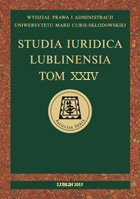
Unemployment of the youth constitutes of the most crucial and painful problems on Polish labour market. The article is devoted to new and modified methods of occupational activation of the young unemployed in the light of the Act of employment promotion and labour market institutions novelized in 2014.
More...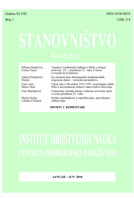
The paper analyses the phenomenon of extramarital births in Serbia in the period of 1950-2008. Great changes that European countries have been undergoing in the last half-century related to fertility and family forms were also followed by an intense increase in the share of extramarital births. This is also true for Serbia (excluding Kosovo), where the share of extramarital births in total live births for the period of 1950-2008 increased almost 3 times (from 8.0% to 22.8%), and their number increased by a fifth (from 13,1 to 15,7 thousand). At the beginning of the observed period, significant differences existed in the percentage shares of extramarital births in the main regions, with the share in Vojvodina several times that of Central Serbia. Subsequent divergent dynamics led to the disappearance of regional differences and, after 1970, the level of extramarital fertility was mostly balanced. From a European aspect, the increase in the share of extramarital births in Serbia was moderate, with Serbia being one of the few countries that also recorded a decrease in the share of extramarital births in the last four decades (between 1970 and 1980). In comparison with other European countries, position of Serbia changed during the observed period from the top towards the bottom of the list, so that it was in its lower half in 2008. During the 1990s, as well as at the beginning of the 2000s, the greatest increase in the share of extramarital births in Europe was recorded in countries in transition. In the paper, the changes in the marital status of the population were treated as one of the determinants of the increase of extramarital births in Serbia. The paper also points out the similarities and differences between births in cohabitation and marriage, and legal aspects related to extramarital unions and extramarital births were also analyzed. The conclusions about the degree of presence of births in stable partner unions were made indirectly, based on the results of survey research and the latest available data on recognition children by their fathers. Since approximately three fifths of extramarital children at the beginning of the 2000s were not recognized, it was assumed that they were born in unstable unions and that they were brought up by their mothers alone. At the same time, the small level of cohabitations, discovered through survey research on the representative sample, shows that the increase in extramarital births was not proportionally followed by an increase in cohabitation. Therefore, based on indirect indicators, the authors conclude that the phenomenon of extramarital birth in Serbia was not the result of an advanced transition in partner relationships and abandoning of marriage as the partner union in which children are born. At the same time, the importance of understanding the social context of births was pointed out on the example of the Czech Republic, as a country in transition.
More...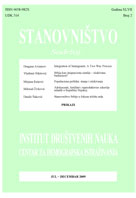
This paper presents data which clearly reveal that the behavior model of young people in the Bosnian Serb Republic is characterized by an insufficient degree of information and poor knowledge on reproductive health, an increase in the number of alcohol consumers, drugs and cigarettes which leads to an increase in risky behavior, entering sexual relations and an earlier age, an increase in the number of sexually transmitted diseases and unwanted pregnancies which often result in abortions or premature birth. At the same time young people recognize the necessity for more information, mention competent authorities and expect help from them. At the same time, they show readiness to learn through peer education. On the other hand, the estimated results which we obtained by using available sources, because of the lack of a population census, give us information on the grave demographic situation in the Bosnian Serb Republic and negative tendencies in the future. When we speak of the total fertility rate and compare these data with countries of Europe and the surrounding areas, we can unfortunately only state that many factors – the most important being: war events, insecurity, unfavorable economic and social situation, significant migration of not only young people but of whole families – caused severely low total fertility rate in the Bosnian Serb Republic. Even worse, these tendencies are further decreasing and society is moving towards open depopulation with unforeseeable demographic, economic and national consequences. At the same time, it has been ascertained that young people are getting married at a later age, deciding on becoming parents at a later age and acting more riskily which decreases their fertility capacity and decreases their share in the total fertility capacity, making the already bad demographic picture of the Bosnian Serb Republic even worse.
More...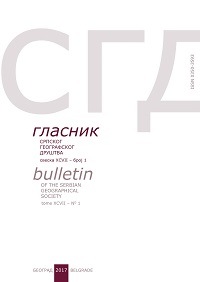
Basic relations between the state of air pollution and their effects on chemistry of precipitation were introduced in this paper. Changes in the composition of atmosphere were defined by numerous chemical elements and compounds different in character which also affect the phenomenon of acidification and alkaline processes. The interconnected sources of emission, relations between urban and rural, the regime of rain measuring system and climate elements combined as whole give us more complete image of the global phenomenon and its effects on cities as a contemporary social development first of all caused by industrialization , its dependance upon fosil sources of energy and demographic pressure. Characteristics of main pollutants were considered as well as their ability to modify atmospheric conditions, but also the influence of climate elements on those conditions, ph rainfall average value movement, seasonal and daily variations, the influence of industrial zones and agglomeration on the conditions in the area much wider than emitters.
More...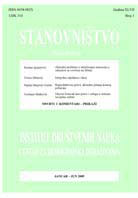
Introduction comprises the information on two main forms of same sex families, civic partnership (same sex partnership) and same sex marriage. Countries and various status modalities of legal regulations are mentioned. The main part of the text is dedicated to presentation of the findings of the most recent research on various aspects regarding children of same sex partnerships. It comprises presentations grouped in four main chapters: acceptance of same sex partnerships, acceptance of legal recognition of the same sex partnerships, family plans of homosexual teenagers, and raising children within and by the same sex partners. Also the real life cases mirroring legal changes through their life destinies are presented, such is e.g. the Irish way to legalization of the same sex partnerships. In addition, a love story of two women crowned by giving birth of their four children is mentioned. Reasons against and negative reactions the author puts under the title Homophobia. In the Concluding remarks, the author presents the most recent examples of legal changes happened in Norway, Ecuador, and in the American states of California and Connecticut. It was also stated that in European countries of low birth rate, the same sex families are inevitably identified as one of demographically valuable source of creating and raising children, which is worthy to be supported, rather than being hindered without reason and discriminated. Although different than a model of heterosexual family, same sex partnerships neither are harrowing to traditional family values, nor reflex of any kind of promiscuous, antisocial behavior, avoidance of parenthood, and negation of family. Quite opposite, these families are an outcome of endeavors of homosexuals not to be deprived of family, parenthood and all of other values of stabile, monogamous, emotional/sexual socially accepted and legally recognized and regulated conventional family.
More...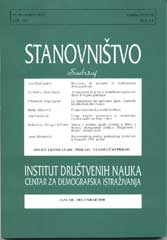
Ever since the 1990’s the number of registered abortions in Serbia has been decreasing from year to year. Are the abortion data of the Public Health Institute complete? In other words, has there been a qualitative shift in the sphere of reproductive behavior of Serbia’s population in the last two decades? This paper deals with the raised question in three ways. First, in an indirect way, by analyzing whether a radical change in birth control since the 1990’s has been possible, having in mind the complexity of the abortion issue in Serbia, as well as the broad social context regarding the last decade of the last century and beginning of this one. The second way deals more directly with the quality of the official data on abortions. Namely, the great decrease in the number of induced abortions, theoretically observed, may be a consequence of the increased level of births, or possibly acceleration in the birth control transition from the use of traditional and inefficient contraception to the usage of modern and efficient methods and means for conception control. For this reason, population fertility trends were analyzed, with a special review on the time period from the 1990’s till present day and the results of the available surveyed researches on the structure of contraception usage in order to determine whether objective assumptions exist for the decrease in the number of induced abortions or not. The third way to reach an answer to the raised question in the title was attempted by estimating the scope of induced abortions. In that sense, relevant literature was consulted and the Westoff method chosen for calculating the rate of total abortions in Serbia (excluding Kosovo and Metohia) in the year 2006. After examining the set task from all three sides, there seemed to be no doubt that the official data on the number of abortions in Serbia are not realistic. The basic reason for incomplete official data on abortions seems to be the fact that in most cases induced abortions performed in private health clinics are not included. Moreover, nurses, namely doctors often experience the filling out of prescribed forms for registration of foetal death as unnecessary, imposed, an additional obligation, without sensing the meaning and not understanding the significance of data as such. The abortion problem in Serbia is serious, complex and demands solving. This assumes the carrying out of many measures, including solving the matter of induced abortions registration. Determination of the realistic number of abortions in a community is very important, because in that way attention is drawn to this health and social problem and enables evaluation of actions to be taken for its alleviation. It remains that the state is to pay due attention to the problem of abortions in Serbia and to put private health clinics in which gynecologists perform abortions under control, as well as to promote the role and significance of statistics among health workers.
More...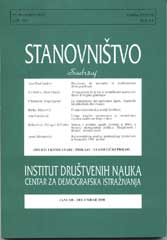
Generations born today, or at least are trying to be, are scarcer than before all over the world. This decrease in the number of children is affecting modern societies in many spheres. If it was to be supported by efficient policies, it could be the source of a general improvement of life conditions. However, if this phenomenon continues or becomes drastic, it could ultimately lead to slower or faster demographic ageing, which could endanger many social heritages. Public intervention must, in that case, impinge much deeper, but without guarantees for a complete, if not permanent, success. The introductory part of the article is dedicated to the concept "demographic revolution" which was developed in 1934 by the French politician and demographer Adolphe Landry, in order to mark the development of a demographic regime which is characterized by a universally accepted practice of birth control, which represents a response for the essential concern for life standard improvement, not only for the parents but their children as well. But then, birth control is the primary cause of population ageing. The article further presents some of the most striking traits of the current French demographic situation, as its future development. France has a positive balance of population exchange with the remaining part of the world, as most of the Western European countries, but still the greatest part of its demographic increase is obtained from a larger number of births than deaths. Because of this, France is often seen as a real demographic paradise in Europe, whose population is decreasing and ageing. This image is certainly flattering, but it is becoming very contradictory after an analysis of long-term trends of fertility indicators and population ageing. The third part of the article, with the situation in France in focus, investigates the modalities and limitations of activities which a society, faced with demographic ageing and decreasing number of children, can apply: policies or simple "adjusting along the way" to demographic processes measures; policies and measures which are more intervening – even in the completely private sphere of birth-giving, and directed towards the limitation of some very unfavorable effects and not towards the change of strongly expressed tendencies of population ageing.
More...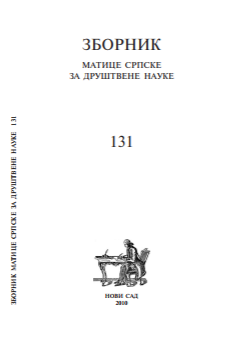
The number of the elderly in the overall population is increasing, which poses a need to seek an adequate model of organizing social care of the elderly. Most of them get social safety through the social welfare system. A functional and sustainable social welfare system requires application of efficient management and technique models based on the theoretical premises of contemporary management. The role and the importance of old people's protection in a social welfare system is becoming a topic of great importance both for theoreticians and the practitioners in the social sector area. This research analyzes the management functions and the roles of managers in running social protection of the elderly in the example of the social welfare system in the Republic of Srpska. A decentralized system, such as the one existing in the Republic of Srpska, brings along a number of organizational problems which points out to a need to apply the theoretical bases of managerial processes. The results obtained via empirical analyses indicate a number of deficiencies and obstacles in the implementation of social protection of the elderly in the social welfare system of the Republic of Srpska which are result of the insufficient and inconsistent application of the basic managerial elements. The obstacles emerging from this analysis indicate that there are chances and opportunities to improve the system and enhance the development of new forms of protection by applying managerial theories.
More...
Analysis of ethnically mixed marriages in the Former Yugoslavia, for the period 1970—2005, shows that after 1990 in all former Yugoslav republics and provinces (except Montenegro) degradation of inter-ethnical relationships induced a fall of inter-ethnical relations, especially at the beginning of 1990. Vojvodina is still singled out (even if there is a decreasing trend after 1990) as a territory with the highest share of exogam marriages (around 25%), while Kosovo and Metohia represent a territory with the lowest shares during the entire period of observation. The most exceptional changes after 1990 occurred in Croatia where the share of ethnically mixed marriages decreased from 19% to around 7% which was mostly a reflection of changes in behaviour of the majority group towards ethnically mixed marriages. The group that was most „open" on the territory of the Former Yugoslavia were the Serbs in Vojvodina until 2001 and after that the Montenegrins, with the highest percentage of interethnic marriages (more than 15%) while all other majority groups are characterized by certain reticence in marrying other nationalities. Concerning the differences between men and women towards ethnically mixed marriages, it shaws that women are, in general, more endogam than men, meaning that they seldom marry outside their group. This is especially characteristic for the Montenegrin's women in Montenegro. When observing the degree of interethnic relations between minority groups and the majority group, it follows that there have not been any changes. In general, degree of integration is higher, meaning that the inter-ethnic relations are more frequent between nationalities that are closer in cultural, religious and linguistic way. Unlike that, during all the period of observation, there is a highly marked segregation between nationalities that belong to different cultural and religious circles, which is especially emphasised in Macedonia.
More...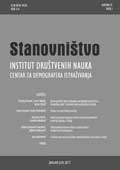
Ethnic diversity in the former Yugoslavia, measured as informational entropy, increased in most regions at the level of the naselje, the opština, and the region, 1961-1991 (no useful data for Slovenia, Macedonia, and Kosovo in 1991). Vojvodina is the most diverse region, Slovenia the least. An exception to theincrease is Kosovo-Metohija, where diversity decreased 1961-1981, driven by already serious interethnic conflict. There is some diminution of the increase in diversity in some regions in 1991, possibly because of refugee flows in anticipation of the impending violence. This rather broad and steady increase in diversity leads to questions about the view that pre-existing ethnic hatreds among broad segments of the population led to the ethnic fracturing and collapse of Yugoslavia. Instead it suggests that this fracturing may instead have been the result of competition between political leaders, stimulated by serious economic difficulties, leading them to emphasize ethnicity in their search for popular support. From this the authors support the view that the collapse of Yugoslavia was from the top downward, not from the bottom upward.
More...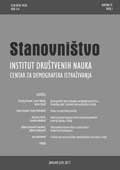
The author analyzes statistical data on position of women in the EU and Serbia, which confirm that women in the EU, as well as in Serbia, are insufficiently represented in decision-making processes, are on average better educated then men, work more hours per day but that they on average earn less then men. Statistical Office of Republic of Serbia has published in 2005 a brochure Women and men in Serbia in which gender sensitive data were published in a coherent way and also data that they gather but do not represent in regular publications, or they do, but disorderly and not systematically. By publishing this brochure it was proved that there is interest and the need to better collect gender sensitive statistical data. Nevertheless, the brochure does not represent a radical breakthrough in methodology of data collection and analysis of new areas in statistics. There are still many "black holes" that Serbia will have to fill in if it wants to respond to its international obligations regarding reporting on position of women to international organizations and various bodies. This is why the author also represented gender sensitive categories which are gathered and published in Germany, Norway and Slovenia – a country where statistics is based on similar grounds which were built in former Yugoslavia and in short time progressed to European standards, proving that progress is possible, if there is political will.
More...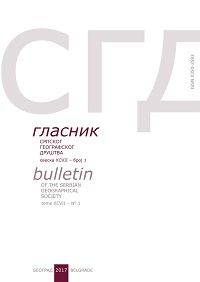
In order to find solutions for stopping negative economic processes in the Raška region, as well as land reclamation and depopulation of villages, one of the main activities is adequate restructuration of the economy, according to available resources. In this paper we analyze a place of tourism in the Raška region, as an activity to which is not given appropriate developmental role in the previous development policies, as opposed to diverse and attractive natural and anthropogenic values. In the paper we identify the most significant tourism potentials of the Raška region and their evaluation score. Special attention is given to rural tourism as one of the activities that can have a greater role in future plans for demographic and economic revitalization of this area. We analyze the current state of rural tourism in the Raška region, and indicate main limiting factors that prevent rapid development of this, in many ways, primary form of tourism.
More...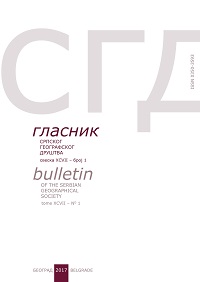
The local geographic milieu plays a significant role in development of every man because of its orientation in space, a sense of security and belonging to the community and the place where he lives or who perform his activities. In other words, one needs to fall in a particular social group that inhabits an area or to perform some activities able in a space, because that is something that stands out from the rest of the world and marking his individuality. The main long-term goal of development of each local community is to increase the quality of life of all its members, job creation, integration of the local community in a wider social system through health, educational and cultural institutions, creating a network of relationships and connections and correlations of all the actors from the state and public sector up to private enterprise, local authorities and local associations. Of particular importance for Serbia, is a question of development of local rural communities, which is closely linked to issues of sustainable and balanced spatial, socio-economic and demographic development. This issue becomes more important in efforts to prevent existing urban-centric trends and highlighted the economic and demographic polarization of Serbia.
More...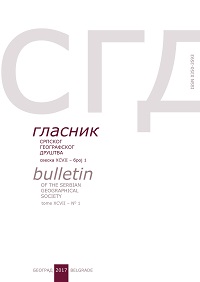
During the 90's, Serbia went through a difficult political and economic changes, which caused a radical decrease in the number of tourists, especially foreigners, as well as a negative perception of Serbia on the global tourist market. After 2000, with political and economic stabilization, Serbia enhanced opportunities for targeting tourists from European tourism market. Despite of its efforts, Serbia has been unable to consistently achieve its goals, which is reflected in the low income from tourism and a small share on the international tourism market. One of the consequences of this scenario might be attributed to Serbia's unfavorable image in the mind of world travelers. This study was conducted with the purpose of analyzing the relationship between destination image of Serbia, overall satisfaction of foreign visitors and their destination loyalty. The survey examines the image held by tourists who visited Serbia during 2007. The data is analyzed qualitatively. The research is applied to event, urban and cruising tourism, as the most attractive forms of tourist movements for foreign visitors.
More...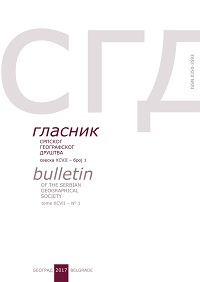
This paper deals with cruises along Corridor 7 and the tourist offer of Serbia. The purpose of the paper has been to establish how international tourists see our country during their travels across Serbia on cruises along Corridor 7. The research has been based on the interviews with international tourists who participated in land tours while cruising through Serbia. The interviews, together with the structured questionnaire, were conducted from March to November 2007 with the objectives to establish the following: the structure of the respondents according to the country of origin, gender and age structure, as well as the social and economic structure; what their motives are for cruising along Corridor 7; what is their perception of the value obtained through the tourist product and services during the Corridor 7 cruises and during their stay in Serbia (what they liked best in Serbia; if they were dissatisfied with anything in terms of the tourist offer of Serbia; to what extent their visit complemented or influenced their personal impressions of this country - what their impressions were before and after the visit). The importance of this paper, above all, is in broadening our knowledge about the adequacy of the tourist offer in Serbia in the tourism segment which is the subject of study of the paper.
More...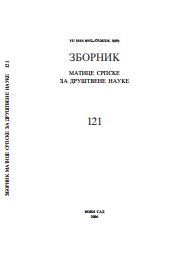
This article presents the ethnic structure of the population of Vojvodina according to the 2002 census results. Also, there are analyzed the ethnodemographic changes in the period 1991–2002, caused by the following relevant factors: natural movement, migration and changed declaration on national affiliation. Ethnocentric migrations (voluntary and forced) primarily influenced the change of ethnic structure of the Vojvodina, in the sense of creating a nationally more homogeneous region, having in mind the national structure of refugee-population. On the other hand, the emigration of some other nationalities which migrated to their mother countries due to political and economic reasons influenced the ethnic structure of the population, too. On the whole, the ethnic picture of Vojvodina is a complex one and undergoing changes continuously. Having in mind that Vojvodina is a multiethnic and multiconfessional region, the question of minorities and interethnic relations is undoubtedly of great significance for the stability and demographic development of this region.
More...
Highly skilled employees are the most valuable part of the migrant labour force. This value is determined by employee’s professional competence, enabling them to contribute significantly to the destination and origin countries’ economic and social development. Global competition for states’ leadership, innovations, economic growth, the rapid and accelerating progress, unsatisfactory demographic processes and along the growing demand for highly skilled labour force impel rich countries to apply international recruitment strategies to attract and hire highly skilled foreign professionals. But what does the very term “abroad” mean to the highly skilled migrants? The research aim is to present the “abroad” image, its variability in time and space and its role in choosing the state of destination. The research object is an image of abroad, created and recreated by highly skilled migrants. This article also analyzes the distinctions between highly skilled migrants and other migrants’ groups, provides the origin of selective immigration programmes, and based on semistructured interviews with highly skilled migrants in natural sciences and technology fields presents the image of “abroad”, its different contents and meanings, depending on time, space and personal future experience.The article reveals that high professional qualification is a fundamental characteristic that distinguishes highly skilled workers from other migrant groups and determines their particular situation before and after migration. Other specific features flow from this fundamental characteristic. These are the high positioning of highly skilled migrants in the hierarchy of jobs, legal employment and social guarantees, less dependent on strong social ties and higher values of weak social ties, a high degree of integration in the country of destination and, therefore, more favourable attitudes of the local population toward highly skilled migrants. The significance of the image of abroad occurs through its power to shape the highly skilled professional’s general approach of abroad, to concentrate “abroad” only to a certain country or region of the world and to shape attitudes toward personal migration and potential country of destination.
More...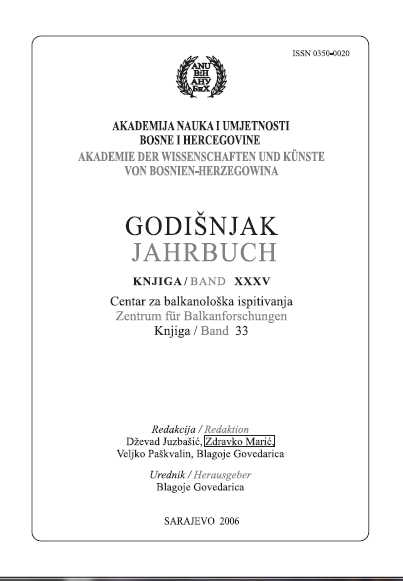
Parallel zur archäologischen Ausgrabung auf dem neolithischen Tell in Okolište wurden seit 2002 pollenanalytische und archäobotanische Untersuchungen durchgeführt. Ziel der naturwissenschaftlichen Begleituntersuchungen war die Rekonstruktion der Landschaftsentwicklung und Landnutzungsgeschichte, sowie die Erforschung der Wirtschaftsweise und Ernährung der neolithischen Bevölkerung. Die pollenanalytischen Untersuchungen wurden im weiteren Raum des Visoko-Beckens durchgeführt. Nachdem eine detailierte Untersuchung von Sedimenten aus dem Grabungsareal aufgrund geringer Pollenführung und schlechter Pollenerhaltung aufgegeben wurde, konnte in einem Niedermoor nahe der Ortschaft Seoce, etwa 7 km nordöstlich von Okolište, eine Bohrung niedergebracht werden. Sie lieferte eine 450 cm lange Sedimentabfolge von organischen Mudden, Tonen und Torfen, wie sie trotz intensiver Prospektion in einem Umkreis von 30 km nicht wieder angetroffen wurde. Vorgestellt wird hier ein vorläufiges Pollendiagramm aus 70 Proben aus allen Profilteilen.
More...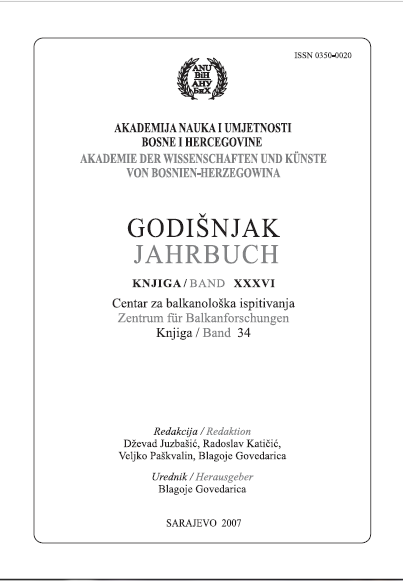
Aufgrund der Prospektions- und Grabungsergebnisse eines bosnisch herzegowinisch/ deutschen Gemeinschaftsprojektes (Kujundžić-Vejzagić i dr. 2004.) besteht die Möglichkeit, demographische Variablen verschiedener Siedlungen im zentralbosnischen Visoko-Becken zu bestimmen. Aus der Rekonstruktion der Häuserzahl pro Siedlung ergeben sich einerseits Einwohnerzahlen von bis zu 1000 Einwohnern pro Dorf bzw. 31E/qkm in den Kernregionen der spätneolithischen Besiedlung, was einer Bevölkerungsdichte von ca. 1,8 E/qkm im gesamten Butmir-Einzugsgebiet entspricht. Diese Werte werden mit denen anderer demographischer Modelle für den südosteuropäischen und mitteleuropäischen Raum verglichen. Andererseits sind eine offene Kulturlandschaft mit einer durchgehend ausgeräumten Feldflur und Formen mobiler Tierhaltung im Gebiet Zentralbosniens zu postulieren.
More...